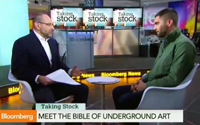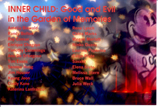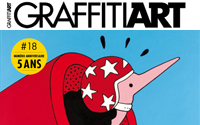
Celebrating 20 Years of Juxtapoz
We speak with Editor in Chief, Evan Pricco, ahead of the publication’s anniversary show, Art Truancy
by Katie Olsen in Culture on May 15, 2014

Founded by artists and collectors back in 1994, Juxtapoz magazine has remained a significant publication and a true champion of the contemporary art world—and those who keep it spinning. Created as the antithesis of the stuffy, old-fashioned scene, the SF-based publication promoted (and continues to promote) artists, galleries and genres that were oftentimes overlooked, and the magazine’s staff has remained ever-vigilant; representing those they believe in, and attempting to make art accessible for everybody.
Two decades of publishing a print magazine and website that covers everything from painting to photography, design, fashion and galleries manifests into a lot of artwork. Opening today, "Art Truancy: Celebrating 20 Years of Juxtapoz Magazine" is going to take over NYC’s Jonathan Levine Gallery‘s two Chelsea spaces with works from the likes of Swoon, Shepard Fairey, James Jean, Camille Rose Garcia, Todd James, Conor Harrington, Sage Vaughn and Brett Amory—plus so many more talented artists who have graced the pages of the magazine. For the past eight years, Evan Pricco has been at the helm as editor of Juxtapoz, and we spoke with him about exemplifying 20 years of the publication, how the internet shaped the art scene and how we owe artists everything.
Truancy is connected with much of the artwork in Juxtapoz (perhaps even more so in the early days). But are there are extra layers to the concept—especially regarding many of the artists involved and the publication’s approach?
I think the "Truancy" title sort of sprung out of this idea that, especially if you look back to the early 1990s when Juxtapoz was founded, the dialogue and narrative of contemporary/gallery art was very much dictated by a blue chip, upper-class, almost aristocracy like mini-universe. Even the idea of an 18-year-old wanting to be an exhibiting artist with a career in fine art was really a far-fetched notion. But there was this undercurrent of artists—be it Robert Williams, R Crumb or S Clay Wilson, who were born out of underground comics with fine art chops, but not the recognition of the fine art establishment—who started to write their own rules, have their own shows and really push the boundaries of what "fine art" careers could potentially look like. They stood outside the traditional avenues of fine art expression, you could say. And so many people helped it grow—Billy Shire, Brad Benedict, Robert Williams, Greg Escalante, Carlo McCormick, I can go on, but these were some first wave supporters of the scene that really helped these "truants" of the art world have a place to be nurtured and create their own art history. I think now Juxtapoz has a bit of a different meaning; 20 years does that to you. I feel like today some of the artists we cover have made it to that blue chip world. But, if you really look at the Art Basel main fair, or Frieze, you may see Mark Ryden, you may see Barry McGee, Kehinde Wiley, Mike Kelley, Barbara Kruger—all artists who have been on the cover of Juxtapoz. Yet much of what we cover still has this absence in what is covered by that world. It still has a rebellious edge, still exists in an outsider context, still creates its own rules.
From a curation angle, how you do properly summarize and exemplify 20 years of a publication in one show?
Great question. I think we had to start at some of the pillar movements and genres that we have covered over the past 20 years—pop-surrealism, graffiti, comic book art, illustration, fine art, street art, car culture—and make sure that we have artists that represent each specific style. That came first. I’m not sure you can fully do it properly—to get everyone who means so much to Juxtapoz in one show, especially because of artists’ own schedules and obligations that they have to fulfill. But what we tried to do, was get the full 20 years into the context of the show. Look at each year, each decade, take a mix of cover artists, people who helped propel the movement forward, and also consider artists who have really been important in recent years. Of course, it was important for Juxtapoz to have Ryden, Shepard Fairey, Swoon, Todd Schorr, James Jean, Camille Rose Garcia, Todd James, because these are are artists who have been on the cover multiple times and made the magazine have such a large reach. But I also wanted to make sure that Conor Harrington, Jeremy Geddes, Saner, Chloe Early, Sage Vaughn, Brett Amory—artists we have championed (and have championed us!)—were in there as well. I think you most certainly miss some artists, but I think we have around 50 artists, and each represent almost more than just themselves in this show.
Is there a through line that you created; a theme to narrow it all down? Or was that impossible?
I think the best way to describe the show is like flipping through the pages of a magazine. A little bit of everything, a little bit from every single year. When we do an issue, you tend to find painting, design, graffiti, and photography—sometimes all in the same article, but definitely throughout the 130+ pages. So the theme I wanted was to make it feel like you were browsing the magazine. I think it worked.
Who has been responsible for selecting the artists/works—did most staff members have a say?
Mostly Jonathan Levine, his staff and I narrowed down the artists and tried to get a good mix of West Coast, East Coast, international and beyond. Jonathan and I have a good rapport, and have a tendency to know each other’s tastes and styles. There were a lot of late night messages back and forth, thinking about which artists to include—and I think that actually was the fun part. I have been at the magazine for eight years and I don’t pretend to know everything that was happening in the Juxtapoz scene in 1994. I listen a lot to the founders, past editors, Jonathan, other curators, because I love the stories of the early years and I want to honor everyone who put the energy and time into making Juxtapoz something that—when I started—was such a big magazine for the contemporary art scene. That said, I have been here for a while now, so I have perspective of what the magazine has championed for the second decade. So in the end, Jonathan and I collaborated on the selection.
So it was important that Levine was included, and that the NYC show is at his gallery?
Jonathan was an early champion of the Juxtapoz scene on the East Coast, and really gave it a home in a city like NYC that is already the capital of the blue chip world. He took risks and chances, and now has two spaces in Chelsea among the Gagosians and Zwirners. That is a big deal: showing lowbrow street art and new contemporary art, and making it in Chelsea is a big deal. His roster and program fits what Juxtapoz has been doing for all our years. From Shepard, to Camille, to Parra, to Brett Amory, to Tim Biskup, to Dalek and all the genres and movements in between, Jonathan LeVine Gallery has had shows with these artists. And when we wanted to do something in NYC, it just made sense.
Can you give us some hints regarding the selected works—what pieces were created especially for the show?
I’m pretty sure that almost every piece in the show is brand new, made specifically for "Art Truancy." And, because we did a good job of being certain of who we wanted in the show as far back as fall, we could talk to artists to give really substantial, beautiful pieces. That said, it’s the artists who spent the time, did the work, make things special. Juxtapoz means a lot of things to many people, but the artists gave really substantial work. Faile, Swoon, Tim Biskup, Dalek, Todd James, Jeff Soto—just off the top of my head—will be exhibiting works that to me exemplify Juxtapoz.
Over the course of 20 years, there have obviously been several shifts in the contemporary, lowbrow graffiti and street art scenes. Has one stood out dramatically—and has Juxtapoz had to change with it?
Two things—and I’m not sure if they answer your question or just have been on my mind. Obviously, the internet changed everything we do, everything the art world is about, everything in general. How that effects contemporary, lowbrow graffiti/street art scenes is that it blended a bunch of creative fields together on a similar platform. And it made art more popular—simple as that. Especially street art and graffiti cultures. Those are two art forms that grew up with the internet, and used that ability to share information through social media to its advantage. Street art especially. Juxtapoz wouldn’t have its international reach if it wasn’t for the way street art and internet have cohabited. European and South American muralism and street art, artists Os Gemeos, Herbert Baglione, Blu, Aryz, Nychos, Ericailcane, Conor Harrington, the ability for someone in San Francisco to see their friend in the South of Italy sharing a mural they saw on the streets by someone like Escif, completely changed our audience. For good, really. It became a way of sharing what people like, and we got to tell the stories of what interested our readers. It also helps that Banksy was nominated for an Academy Award, Shepard Fairey helped nominate a president, Spike Jonze turned skateboard aesthetics into a major film career, Mark Ryden has record-breaking sales, Robert Williams is in the Whitney Bienale, KAWS is art directing the VMAS, Swoon is in the Brooklyn Museum, etc. The artists are pretty special—and we owe them everything. The other thing that I think has been such a big deal since we started is the rise of creative culture. More people seem to be interested in art school, in working in jobs around design, film, photography and even being an exhibiting fine artist with a career in painting. More people want to go to art fairs. More people want to take photos and Instagram murals and street art. More people want interesting tattoos. More people like a little vandalism and see cool graffiti. More people know Banksy, Shepard Fairey, Swoon. There are so many opportunities for creative jobs now, and I think that both fuels our readership—and we in turn try to inspire our readers with people who are making their careers in creativity.
Do you think there is a standout reason Juxtapoz has remained a relevant and significant publication (both in print and online) for art enthusiasts over all this time?
It’s a mix of sharing creative energy to readers who are interested in how art can be a lifestyle. We never rested on covering one style, we continue to broaden our scope, the artists continue to make interesting and provocative works, and the readership keeps passing the magazine to the next generation to be inspired. One of things I think we have done really well is mixed and matched content for art enthusiasts. We highlight photography, design, fashion, painting, graffiti, galleries, museums and current events in each issue. If you like 50% of one month content, you may like 90% the next. But our readers respect that there is a lot going on in art every month, and they can come to the print mag or the web and get a great slice of it. We work really hard to cover as much as we can for everyone’s interests. Our staff—from in-house in San Francisco to LA, Chicago, NYC, to Mexico City—are really good at knowing what’s up.
What do you hope for the next 20 years of Juxtapoz?
I’m just trying to get through 2014! Working on a new Jux book, this show, a new issue every four weeks, our nonstop website—that is a lot. But in my dream world, I think I want to figure out more ways to get artists into their dream projects. More and more, as we launch Juxtapoz Projects—which is what we call our site-specific projects—we just want to be able to give artists that opportunity to build the things they want to build. Public Art is a big part of it, making art accessible to people who are intimidated by institutional art. Juxtapoz Projects is the next place where our energy is going.
"Art Truancy: Celebrating 20 Years of Juxtapoz Magazine" is on at both Jonathan Levine Galleries (557C West 23rd St and 529 West 20th St), 15 May through 14 June.
Photos by Hans Aschim
http://www.coolhunting.com/culture/juxtapoz-art-truancy-show.php






